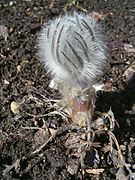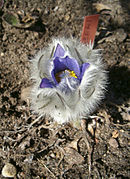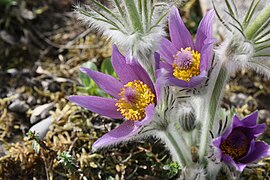en
names in breadcrumbs


Anemone halleri, ye una planta yerbácea de la familia de les ranunculacees.
Ye nativa d'Europa.
Ye una planta perenne, de crecedera lenta, con raigaños fondos. Les fueyes son llanudes, sobremanera basal y nos nervios de la fueya, con trés a cinco segmentos principales, el segmentu terminal que tien un tarmu llargu. Los tarmos florales son aproximao de 5 cm d'altor nel momentu del floriamientu, allargar más tarde. Les fueyes del tarmu son filiformes y atópense nun aniellu debaxo de la flor. Les flores son de color azul o púrpura, con seis pétalos, de 6-8 cm de diámetru. Les flores tienen munches anteres marielles y munchos estigmes, los estilos sedosos persisten pa formar una vela qu'ayuda a la dispersión de los frutos.[1]
Orixinaria de sur-esti de Francia, sur de Suiza y Polonia, que s'estiende escontra l'este de Grecia, Bulgaria y península de Crimea.
Anemone halleri, describióse por Carlo Allioni y espublizóse en Auctarium ad Synopsim Methodicam Stirpium Horti Reg. Taurinensis 40. 1773.[2]
Anemone: nome xenéricu que vien de la pallabra griega Άνεμος, que significa vientu.
halleri: epítetu dau n'honor del botánicu Albrecht von Haller.
 Esta páxina forma parte del wikiproyeutu Botánica, un esfuerciu collaborativu col fin d'ameyorar y organizar tolos conteníos rellacionaos con esti tema. Visita la páxina d'alderique del proyeutu pa collaborar y facer entrugues o suxerencies.
Esta páxina forma parte del wikiproyeutu Botánica, un esfuerciu collaborativu col fin d'ameyorar y organizar tolos conteníos rellacionaos con esti tema. Visita la páxina d'alderique del proyeutu pa collaborar y facer entrugues o suxerencies. Anemone halleri, ye una planta yerbácea de la familia de les ranunculacees.
Haller güləbətini (lat. Pulsatilla halleri)[1] - güləbətin cinsinə aid bitki növü.[2]
Hallers Kuhschelle oder Hallers Küchenschelle (Pulsatilla halleri) ist eine Pflanzenart aus der Gattung der Kuhschellen (Pulsatilla) in der Familie der Hahnenfußgewächse (Ranunculaceae). Sie kommt von den Seealpen bis ins Wallis sowie in der Steiermark und auf der Balkanhalbinsel, in den Karpaten und auf der Krim vor.
Hallers Kuhschelle ist eine ausdauernde krautige Pflanze, die Wuchshöhen von 5 bis 30 Zentimeter erreicht. Der aufrechte Stängel ist weißzottig behaart. Die Grundblätter sind nicht überwinternd, sondern entwickeln sich erst mit Beginn der Blüte. Die 5 bis 7 Zentimetern lange, gefiederte Blattspreite besteht aus fiederteiligen, spitzzipfligen Teilblättern. Oberseits sind diese von 2 bis 4 Millimetern langen Seidenhaaren bedeckt.
Die Blütezeit reicht von Mai bis Juli. Die Hochblätter sind an ihrer Basis verwachsen und in linealische, seidenhaarig-zottige Zipfel zerschlitzt. Die endständig, einzeln und aufrecht stehenden Blüten sind anfangs glockig und später ausgebreitet. Die meist sechs hell- bis blauvioletten, außen behaarten Blütenhüllblätter sind mit einer Länge von 20 bis 30 Millimeter eiförmig und zugespitzt. Die Früchtchen besitzen bis zu 40 Millimeter lange, behaarte Griffel in einem haarschopfigen Fruchtstand.
Die Chromosomenzahl beträgt 2n = 32.[1]
Hallers Kuhschelle kommt in den Seealpen bis Wallis sowie in der Steiermark vor. Vorwiegend in den subalpinen bis alpinen Höhenstufen gedeiht Hallers Kuhschelle in Höhenlagen bis zu 3000 Metern auf kalkhaltigen, trockenen Böden, auf Geröll und in Felsspalten. Hallers Kuhschelle ist nicht häufig.
Die Erstbeschreibung von Pulsatilla halleri erfolgte 1809 durch Carl Ludwig von Willdenow in Enumeratio Plantarum Horti Regii Botanici Berolinensis: continens descriptiones omnium vegetabilium in horto dicto cultorum, 1, S. 580.
Es wurden fünf Unterarten beschrieben, sie werden aber nicht von allen Autoren als gültig anerkannt; hier eine Liste aus dem vorigen Jahrhundert (bevor molekulargenetischen Daten erhoben werden konnten):
Die Unterarten besitzen aber unterschiedliche Verbreitungsgebiete und so ist das Gesamtverbreitungsgebiet davon abhängig, welche der Unterarten als eigene Arten gewertet werden oder nicht.[2]
Nach Ansicht verschiedener Autoren gehören alle Pulsatilla-Arten zur Gattung Anemone, deshalb gibt es auch die entsprechenden Synonyme (Anemone halleri All., Anemone glacialis Clairv., Anemone hackelii Steud., Anemone hybrida Miq. ex Pritz., Anemone janczewskii Giraudias, Anemone patens Hoppe, Anemone pinnatifida Dulac)[3].
Hallers Kuhschelle oder Hallers Küchenschelle (Pulsatilla halleri) ist eine Pflanzenart aus der Gattung der Kuhschellen (Pulsatilla) in der Familie der Hahnenfußgewächse (Ranunculaceae). Sie kommt von den Seealpen bis ins Wallis sowie in der Steiermark und auf der Balkanhalbinsel, in den Karpaten und auf der Krim vor.
Anemone halleri, Haller's anemone, is a species of flowering plant in the buttercup family Ranunculaceae, that can be found in sub-alpine and alpine regions of southern France, southern Switzerland, northern Italy and Poland, extending eastward to Greece, Bulgaria and Ukraine. It is found in mountain meadows, dry hills, dry grassy locations and mountainous forest glades. It is collected and cultivated for botanical and private gardens.
Growing in clumps to 20 cm (7.9 in) tall and wide, this herbaceous perennial has hairy grey-green foliage, and in spring produces pink or purple flowers which form ornamental silky seedheads. It prefers an exposed, well-drained position in full sun. [3]
Anemone halleri is mildly toxic, and can cause stomach ache on skin contact.[3]
It is still widely referenced under its former name, Pulsatilla halleri. The species [3] and the subspecies P. halleri subsp. slavica are recipients of the Royal Horticultural Society's Award of Garden Merit.[4]
Anemone halleri, Haller's anemone, is a species of flowering plant in the buttercup family Ranunculaceae, that can be found in sub-alpine and alpine regions of southern France, southern Switzerland, northern Italy and Poland, extending eastward to Greece, Bulgaria and Ukraine. It is found in mountain meadows, dry hills, dry grassy locations and mountainous forest glades. It is collected and cultivated for botanical and private gardens.
Growing in clumps to 20 cm (7.9 in) tall and wide, this herbaceous perennial has hairy grey-green foliage, and in spring produces pink or purple flowers which form ornamental silky seedheads. It prefers an exposed, well-drained position in full sun.
Anemone halleri is mildly toxic, and can cause stomach ache on skin contact.
It is still widely referenced under its former name, Pulsatilla halleri. The species and the subspecies P. halleri subsp. slavica are recipients of the Royal Horticultural Society's Award of Garden Merit.



Anemone halleri es una planta herbácea de la familia de las ranunculáceas. Es nativa de Europa.
Es una planta perenne, de crecimiento lento, con raíces profundas. Las hojas son lanosas, sobre todo basal y en los nervios de la hoja, con tres a cinco segmentos principales, el segmento terminal que tiene un tallo largo. Los tallos florales son aproximadamente de 5 cm de altura en el momento de la floración, alargándose más tarde. Las hojas del tallo son filiformes y se encuentran en un anillo debajo de la flor. Las flores son de color azul o púrpura, con seis pétalos, de 6-8 cm de diámetro. Las flores tienen muchas anteras amarillas y muchos estigmas, los estilos sedosos persisten para formar una vela que ayuda a la dispersión de los frutos.[1]
Originaria de sur-este de Francia, sur de Suiza y Polonia, que se extiende hacia el este de Grecia, Bulgaria y Crimea.
Anemone halleri, fue descrita por Carlo Allioni y publicado en Auctarium ad Synopsim Methodicam Stirpium Horti Reg. Taurinensis 40. 1773.[2]
Anemone: nombre genérico que procede de la palabra griega Άνεμος, que significa viento.
halleri: epíteto otorgado en honor del botánico Albrecht von Haller.
Anemone halleri es una planta herbácea de la familia de las ranunculáceas. Es nativa de Europa.
Pulsatilla halleri
La Pulsatille de Haller (Pulsatilla halleri), également appelée Anémone de Haller, est une espèce de plantes herbacées vivaces du genre des Pulsatilles et de la famille des Renonculacées.
Cette anémone se rencontre dans les pelouses alpines et les rocailles. Elle mesure de 6 à 20 centimètres[1]. Ses feuilles et sa tige sont entièrement velues. Les fleurs sont lilas à mauves. La floraison a lieu en juin-juillet.
Pulsatilla halleri
La Pulsatille de Haller (Pulsatilla halleri), également appelée Anémone de Haller, est une espèce de plantes herbacées vivaces du genre des Pulsatilles et de la famille des Renonculacées.
Heiðabjalla (fræðiheiti: Pulsatilla halleri) er blóm af sóleyjaætt. Blómin er eru bjöllulaga og fjólublá.
Anemone halleri là một loài thực vật có hoa trong họ Mao lương. Loài này được All. mô tả khoa học đầu tiên năm 1785.[1]
Anemone halleri là một loài thực vật có hoa trong họ Mao lương. Loài này được All. mô tả khoa học đầu tiên năm 1785.